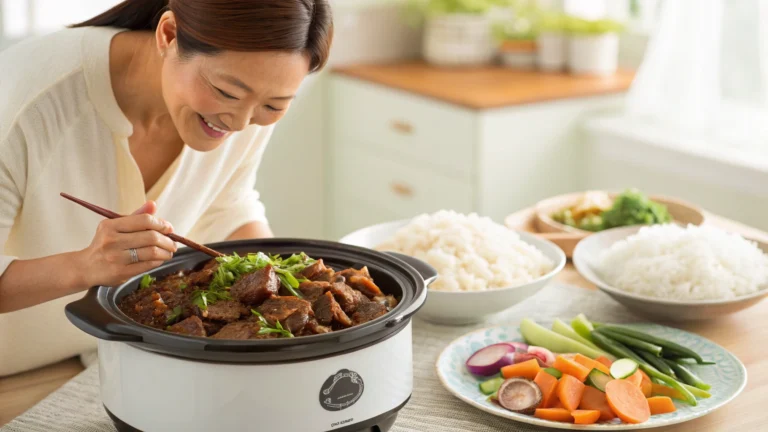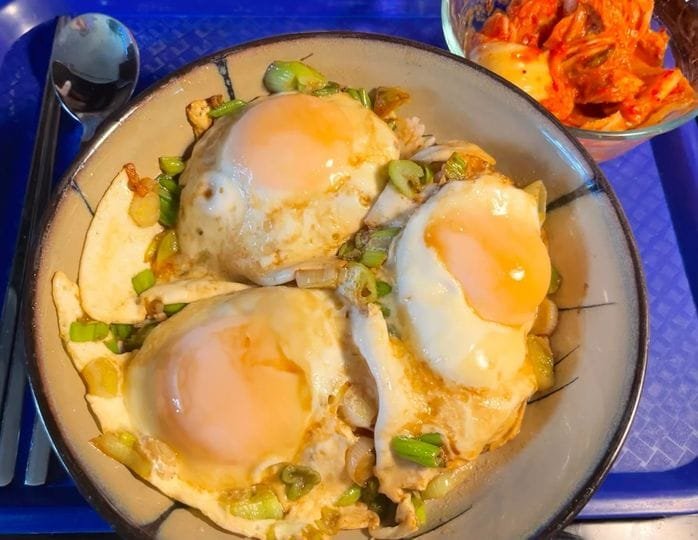Ssam-mu: Korean Pickled Radish
Discover the unique taste of Ssam-mu! This guide explores this versatile Korean pickled radish, its history, how to prepare it, and its place in cuisine.
Introduction to Ssam-mu
Have you ever experienced a side dish that adds a vibrant crunch and tangy flavor to your meals? That’s exactly what Ssam-mu, the traditional Korean pickled radish, brings to the table. This versatile banchan (side dish) is not just a simple accompaniment, it is also a key component of many Korean dishes. This article is a comprehensive guide to Ssam-mu. We will delve into its origins, explore the many variations, discuss its culinary significance, provide a detailed recipe, and explain where to buy it. Therefore, this guide will equip you with all the knowledge you need to appreciate and enjoy this staple of Korean cuisine.
Understanding Ssam-mu
What Is Ssam-mu?
Ssam-mu, pronounced “ssahm-moo,” literally translates to “wrap radish.” This name accurately describes its use in Korean cuisine, often acting as a “wrapper” for various foods. This traditional Korean pickle is made primarily from mu, the white Korean radish, also known as daikon. Furthermore, the radish is thinly sliced and then pickled in a sweet, sour, and salty brine. This process results in a refreshing, crunchy, and flavorful dish with a distinct taste and texture. The use of a specific type of radish, along with the distinct pickling method, makes Ssam-mu unique from other types of pickles.
Key Characteristics of Korean Pickled Radish
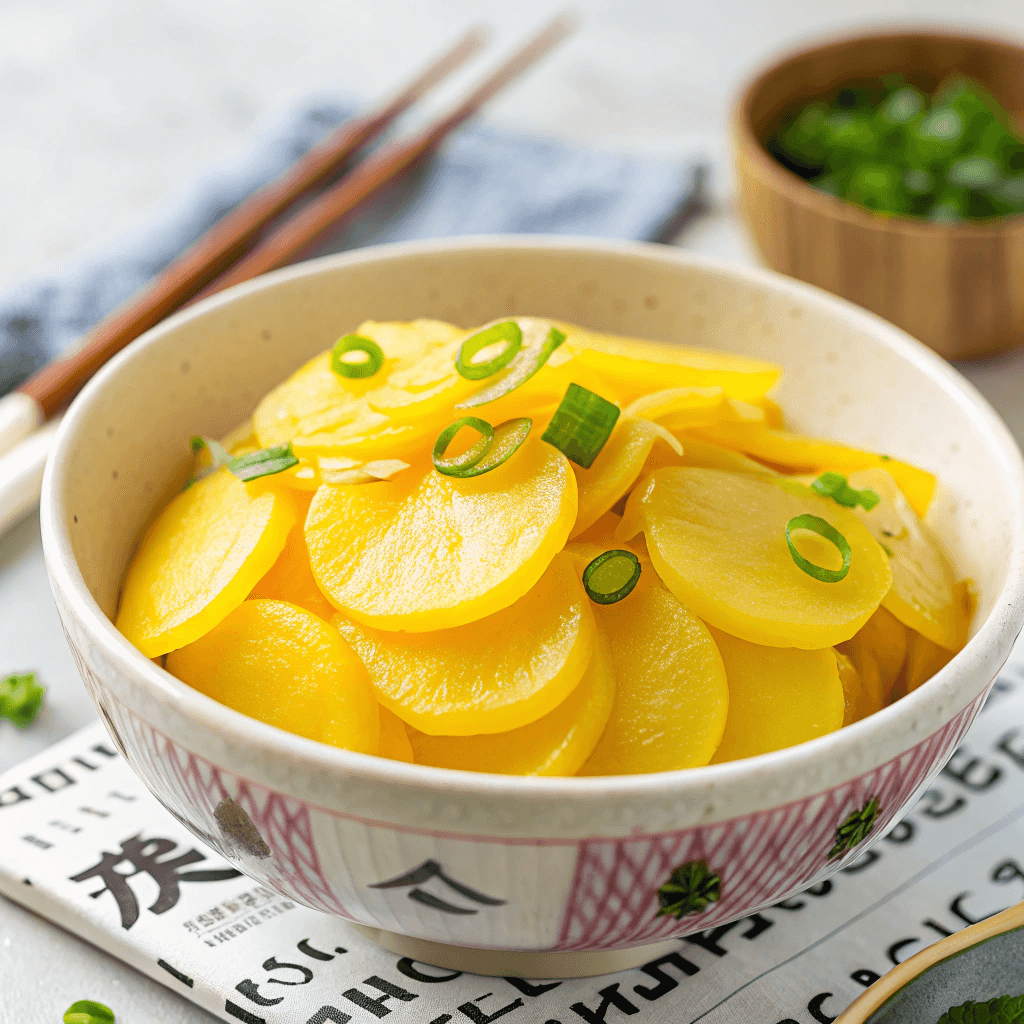
Ssam-mu is distinguished by several characteristics. Its thin, almost translucent slices are crucial to its light texture. Moreover, its flavor profile is a balanced combination of sweet, sour, and salty notes, making it an incredibly versatile side dish. The pickling process gives it a crisp, refreshing quality, and its bright yellow or white color is visually appealing. Therefore, it’s a side that is both tasty and visually appealing. Finally, its balanced flavor and texture allow it to compliment different types of food.
Ssam-mu vs Other Pickles
While many cultures have their own pickled vegetables, Ssam-mu is unique due to its distinct preparation and flavor. In contrast to American dill pickles, which rely on dill and fermentation, or the spicy intensity of kimchi, Ssam-mu offers a mild, sweet, and tangy experience. This distinct difference makes it an essential element in Korean cuisine. Therefore, understanding the differences is important to appreciating the versatility of this Korean side dish.
Variations of Ssam-mu
Classic Yellow Ssam-mu
The most common form is the classic, bright yellow Ssam-mu. This is achieved by adding food coloring (often turmeric) to the pickling brine. Its taste is balanced and offers a nice combination of sweet, sour and salty. This classic version is enjoyed with many different meals.
White (Non-Dyed) Ssam-mu
A white version also exists, which omits food coloring. This allows the natural color of the radish to remain. This version tends to have a milder flavor, allowing the taste of the radish to come through more prominently. Therefore, it is a great alternative for those who do not want any food coloring.
Regional and Flavor Variations
Furthermore, Ssam-mu can also vary regionally and based on different taste preferences. Some variations might include the addition of spices such as peppercorns, or red chili flakes. Similarly, different sweeteners like honey or maple syrup can be used to adjust the sweetness. Therefore, it is a very versatile dish that can be altered according to individual tastes.
Ssam-mu in Korean Cuisine
Ssam-mu as a Banchan
Ssam-mu is a staple in Korean cuisine. Primarily, it is served as a banchan, a side dish accompanying almost every Korean meal. Its refreshing crispness and balanced flavors help cleanse the palate. In addition, it cuts through the richness of heavier dishes. Therefore, it is an important part of any Korean meal.
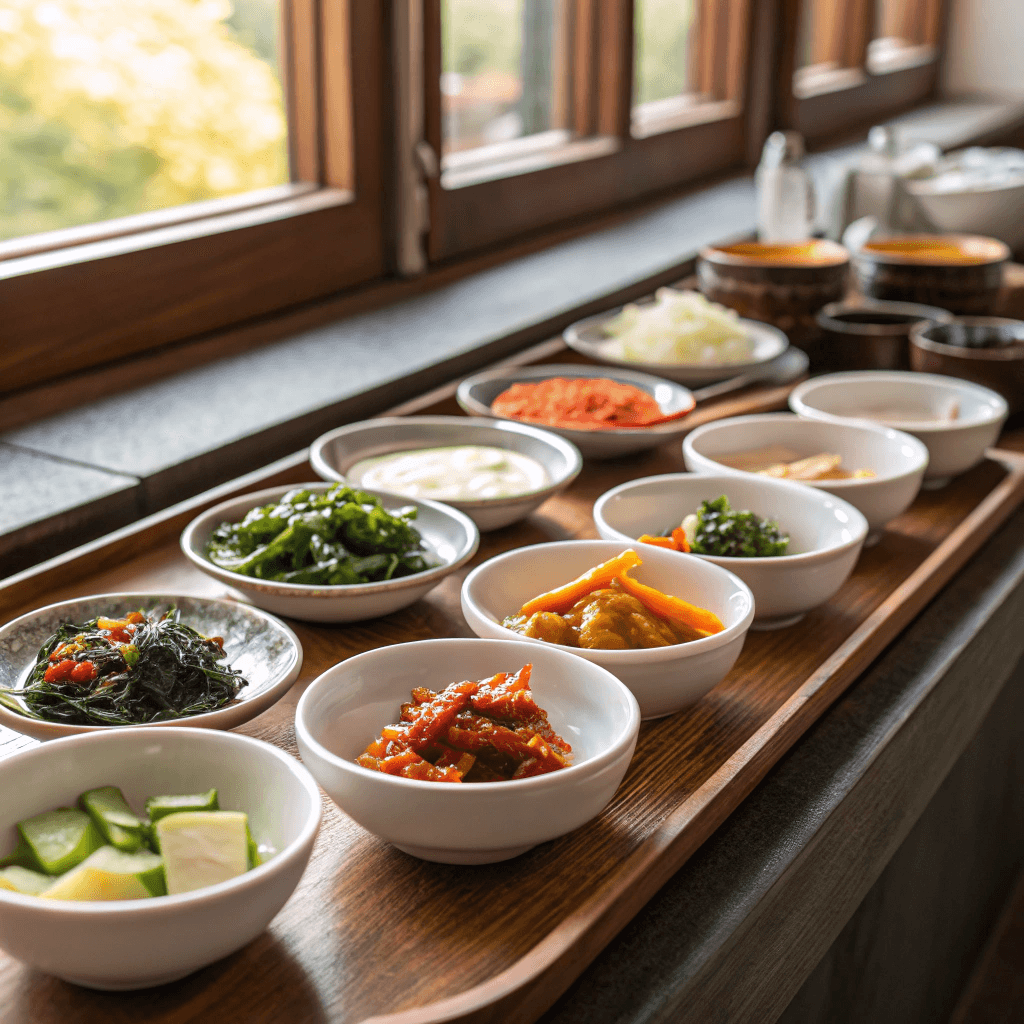
Ssam-mu in Korean Wraps
Its literal meaning, “wrap radish,” highlights its use in ssam (Korean wraps). It is used as a base for various wraps, where other meats, vegetables, and sauces are placed inside, creating a flavorful and delicious bite. This method allows you to truly experience the wonderful combination of textures and flavors. Therefore, it’s an essential component of any Korean wrap.
Culinary Versatility of Ssam-mu
Beyond its traditional use, Ssam-mu also adds a unique twist to various dishes. It can be used as a garnish, an ingredient in salads, or as a topping for sandwiches. For example, it can be a great pairing to rich and savory meals. Its versatility makes it a great addition to any cuisine.
Making Ssam-mu at Home
Ingredients List
- 1 large Korean radish (mu/daikon)
- 1 cup white vinegar
- ½ cup granulated sugar
- 1 tablespoon salt
- 1 cup water
- Optional: Yellow food coloring (or turmeric), or pink or red food coloring
- Optional: spices such as peppercorns, or red chili flakes
Step-by-Step Instructions
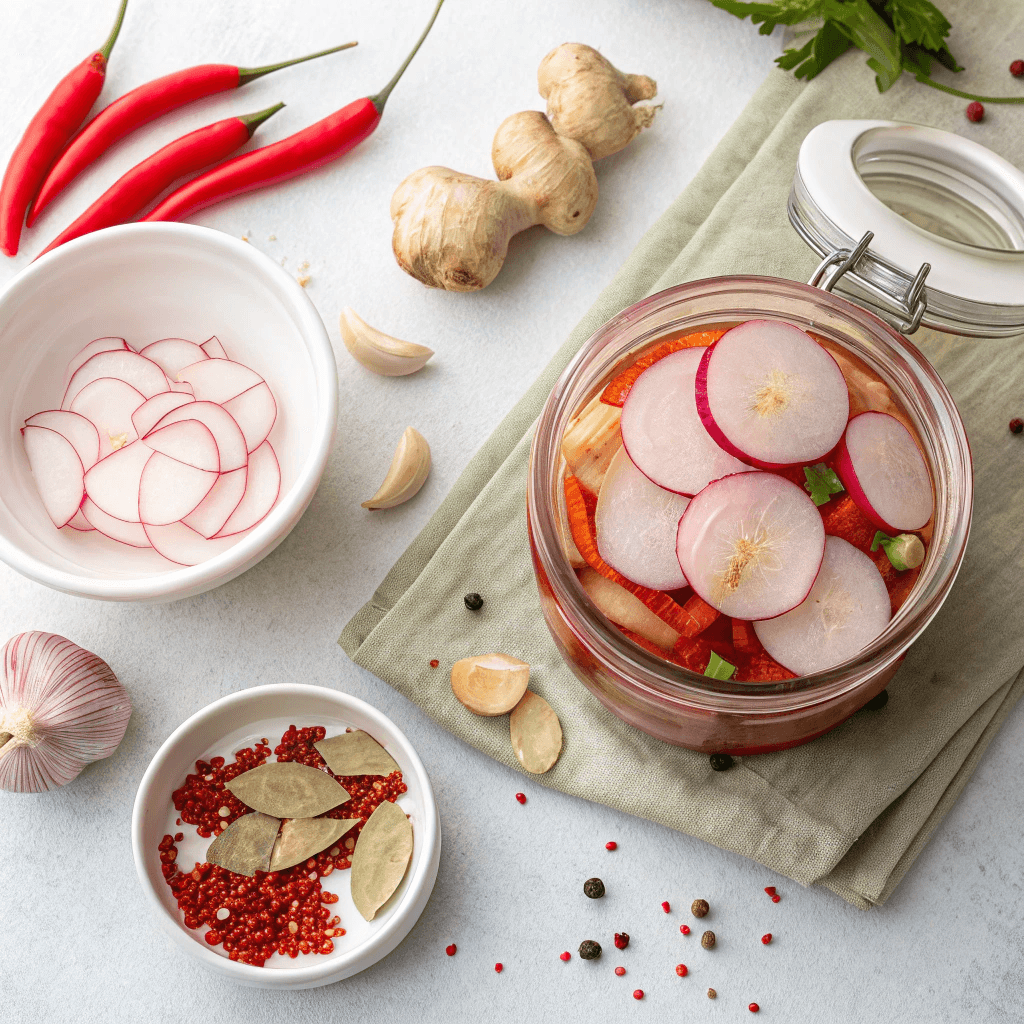
- Prepare the Radish: Begin by thoroughly washing the radish and peeling its skin. Thinly slice the radish into even slices (about ⅛ inch thick). Using a mandoline slicer will help achieve uniform slices.
- Create the Brine: In a mixing bowl, combine the white vinegar, sugar, salt, and water. Stir until the sugar and salt are completely dissolved. If desired, add your preferred food coloring or spices.
- Pickle the Radish: Place the radish slices into an airtight container or resealable bag. Then, pour the brine over the radish slices, ensuring they are completely submerged in the liquid.
- Marinate: Seal the container and place it in the refrigerator for a minimum of 24 hours, ideally 48 hours. This allows the radish to fully absorb the pickling flavors.
- Storage: After the marinating time, your Ssam-mu is ready to serve. Store it in the refrigerator, in the same container it was marinated. It will keep well for several weeks.
Tips for Perfect Ssam-mu
- Crispness: To achieve optimal crispness, make sure that the radish is very fresh, and slice it as thinly as possible.
- Taste Adjustment: Adjust the amount of sugar and vinegar to your personal preferences. Add more sugar for a sweeter taste, and more vinegar for a tangier taste.
- Slicing: For uniform slices, using a mandoline slicer is ideal.
- Marinating Time: Marinating it longer will result in a more flavorful Ssam-mu.
- Variation: Instead of sugar, try using honey or maple syrup as a sweetener. Add additional spices like peppercorns, or red chili flakes for more flavor.
Troubleshooting
- Brine too sour: If the brine is too sour, add more sugar to create a balance.
- Brine too sweet: If the brine is too sweet, add more vinegar to balance it out.
- Radish not crisp: Make sure your radish slices are very thin and are made with a fresh radish.
- Uneven Flavor: Ensure even slicing so the brine is absorbed equally.
Serving Suggestions
Serve homemade Ssam-mu chilled, as a side dish, or as an ingredient for wraps and garnishes. Try it with both Korean and non-Korean cuisine.
Where to Buy Ssam-mu
Asian Supermarkets
You can find pre-made Ssam-mu in Asian supermarkets, usually in the refrigerated section with other banchan (side dishes).
Online Retailers
Various online retailers offer different brands of Ssam-mu, providing a convenient option if there are no Asian supermarkets nearby.
Grocery Store Options
Some mainstream grocery stores with international food sections may carry Ssam-mu, however, the options may be limited compared to a specialty store.
What to Look For
When buying pre-made Ssam-mu, make sure to check the ingredient list, ensuring there are no unwanted additives. Examine the packaging, and the color, to ensure it’s fresh.
Storing and Shelf Life
Optimal Storage Conditions
Always store Ssam-mu in the refrigerator, in an airtight container, to preserve its crispness and taste. Keeping it at a constant cool temperature is essential to maintain its quality.
Shelf Life
Homemade Ssam-mu typically lasts for several weeks in the fridge. Store-bought versions can sometimes last longer, but it’s best to check the expiration date on the package.
Signs of Spoilage
Discard any Ssam-mu that develops an odd odor, slimy texture, or any signs of mold. Always ensure you are consuming fresh, properly stored food.
Creative Serving Ideas
Unique Serving Suggestions
Ssam-mu can be added to salads for an extra crunch, as a garnish for various dishes, or even as a topping for sandwiches. Its versatility means it can be enjoyed in different contexts, and cuisines.
Pairing Ideas
For example, it tastes wonderful with grilled meats, and cheese plates, or added to wraps. Therefore, it can be used in many ways, so feel free to experiment.

Nutritional Benefits
Health Benefits
Ssam-mu is a low-calorie food, rich in vitamins and minerals. It is also a great source of fiber, which promotes digestive health. Furthermore, the pickling process creates probiotics, which are good for gut health.
Nutritional Breakdown
- Nutrient Content (per 100g)
| Nutrient | Amount (approx.) |
| Calories | 25-30 kcal |
| Total Fat | 0.1g |
| Saturated Fat | 0g |
| Cholesterol | 0mg |
| Sodium | 100-200mg |
| Total Carbohydrate | 6-7g |
| Dietary Fiber | 1-2g |
| Total Sugars | 3-4g |
| Protein | 0.5g |
| Vitamin C | 10-15mg |
| Potassium | 150-200mg |
| Folate | 10-15mcg |
Disclaimer: Nutritional information may vary slightly based on the preparation.
FAQ Section:
Is Ssam Mu healthy?
Yes, Ssam-mu is a healthy food option. It is low in calories and rich in essential vitamins and minerals. The fiber content also promotes a healthy digestive system. Also, the probiotics resulting from the pickling process can aid in gut health.
What is SSAM MU in Korean?
In Korean, “Ssam-mu” (쌈무) translates literally to “wrap radish.” This name refers to the popular use of this side dish as a wrapping or base for other foods.
How to store Korean mu?
Korean mu (daikon radish) should be stored in a cool, dry place. The refrigerator’s crisper drawer is the best option, where it can last for a few weeks. Once cut, wrap it tightly in plastic wrap or place it in an airtight container and store it in the refrigerator.
How long can I keep Korean pickled radishes?
Korean pickled radishes, including Ssam-mu, can be stored in the refrigerator for several weeks, if stored properly. Homemade Ssam-mu can last for a few weeks, and store-bought versions can last longer as they sometimes contain additional preservatives. However, it is always best to check the expiry date. If it develops an odd smell or a slimy texture, discard it.
Conclusion
Ssam-mu is a delightful Korean pickled radish with a unique balance of sweet, sour, and salty flavors. Its versatility makes it a wonderful addition to many types of meals. Furthermore, it is also packed with nutritional benefits. Try our recipe and elevate your meals today!
“Ssam-mu, a staple in Korean cuisine, is a type of pickled radish made primarily from mu, the white Korean radish, also known as daikon. Learn more about daikon radish here. This pickling process, to learn more about pickling click here, enhances the presence of beneficial probiotics, which can further aid in digestion, for more information on probiotics, read this article. Ssam-mu is also packed with essential vitamins and minerals, like Vitamin C. Learn more about the benefits of Vitamin C. Often served as a banchan, explore more Korean side dishes here, it is also a key component of ssam, or Korean wraps, where other meats, vegetables, and sauces, including ssam sauce, are placed inside.”
don’t hesitate to check our recipes for more taste ;
Dotorimuk Muchim: delicious Acorn Jelly Salad



